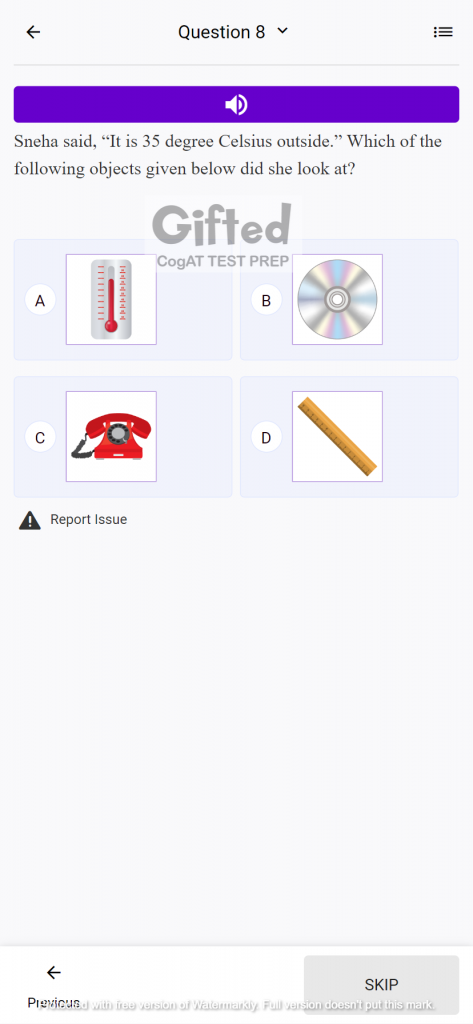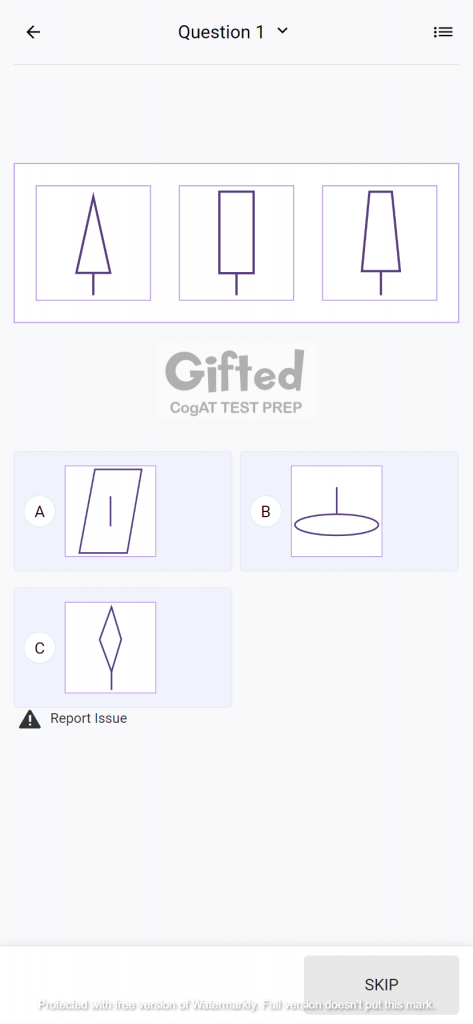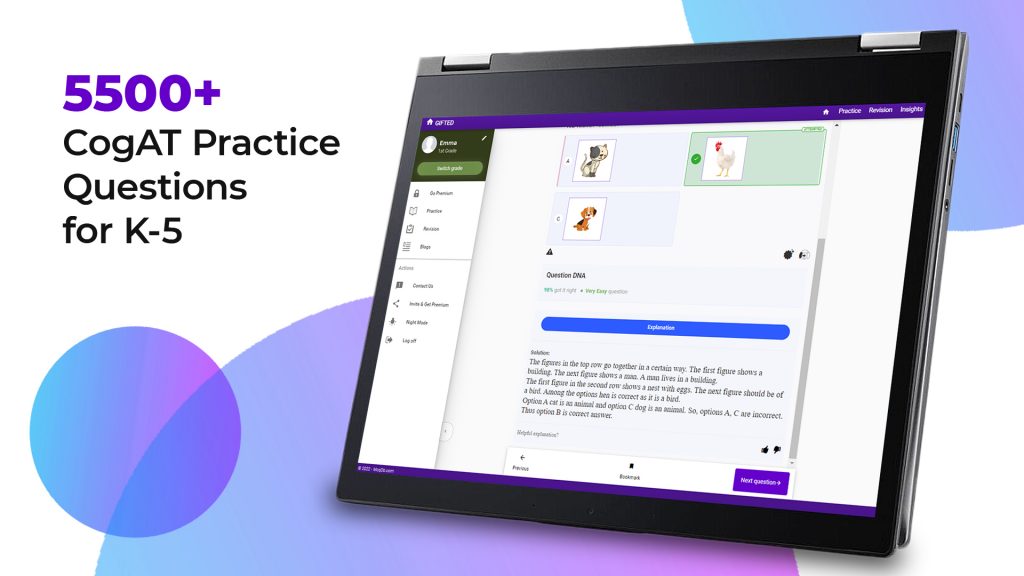CogAT (cognitive abilities test) is a multiple-choice exam used to measure different aspects of students’ intelligence and reasoning skills. It is a nationally standardized test that measures general as well as specific cognitive abilities. The CogAT test is used to get a child admitted into a gifted and talented program. It is divided into 3 batteries - verbal, quantitative, and nonverbal with sections and their own set of questions tailor-made as per the student’s grade level.
Both parents and students may have doubts regarding the CogAT test. In this blog, we will look at some of the frequently asked questions related to CogAT.
Q 1. Why is CogAT important?
A. CogAT is an important evaluation for many reasons. It aids to assess students' problem-solving and learning capacities as well as cognitive skills. Apart from this, in order to be eligible for admission, several gifted and talented programs across the US need the students to take CogAT. As most of the content of CogAT form 8 is nonverbal, it comes in handy in testing non-native english speakers.
Q 2. Who can appear in CogAT?
A. CogAT is given by students between the ages of 5 and 18. It is used primarily in schools and the main aim of the cognitive abilities test is to decide whether a child is eligible to get into the gifted education program.
Q 3. How do I register my child to take the CogAT?
A. The CogAT test is administered in a variety of ways and therefore registration for the test changes. You can find out when the exam will be given by the school district. Contact your child’s school to learn more.
Q 4. How many questions are on the CogAT test and how much time is given to complete the test?
A. The number of questions on the CogAT Form 8 depends on the exam level. The administration time varies depending on the time the proctor takes to conduct the test. Students are generally given between 30-45 minutes per battery and including the administrative time, it takes around two to three hours to complete all the batteries. Depending on the level, the CogAT has a total of 118 to 176 questions. The number of questions by level is shown in the table below.

Q 5. When is the CogAT test administered?
A. The CogAT test usually happens between October – March but it's always better to check the exact date with your child’s school district.
Q 6. How do the three sections of the CogAT differ?
A. As mentioned above, CogAT comprises three batteries. Let’s take a closer look at them -
The verbal battery comprises three sections - picture analogies, sentence completion, and picture classification. The flexibility, fluency, and adaptability of a person's verbal reasoning skills are judged by this battery. These reasoning skills play a crucial role in reading comprehension, critical thinking, writing, and other verbal learning tasks.

The three sections of quantitative battery are number analogies, number puzzles, and number series. It evaluates the student’s ability to organize, structure, and interpret a collection of numerical values and mathematical symbols as well as his/her responsiveness and ease while working with quantitative symbols and concepts. In mathematics and other subjects, problem-solving is closely related to these thinking abilities.

Figure matrices, paper folding, and figure classification are the three sections of nonverbal battery. It is given to identify logic using geometric shapes and figures. Students who want to perform well must discover methods to resolve unusual challenges quickly. They have to be agile and accurate while implementing them.

Q 7. What type of results does the CogAT provide?
CogAT provides raw scores, standard age and grade scores, percentile rank scores, and stanine scores.
The raw scores are derived by the combination of the number of questions asked in a particular section, the total questions answered by the student, and the number of questions answered correctly.
The standard age score, or SAS, is a number that the teacher can use to compare a student's cognitive development to other students of the same age or grade. The maximum SAS score a kid can get on the CogAT is 150.
A percentile rank shows the proportion of students in the same age or grade group whose scores are lower than the score of a particular student.
The stanine score is a way to scale test grades on a nine-point standard scale ranging from 1-9 and is highly connected to the percentile rankings. Stanines scores are grouped as follows:
9: Very High
7-8: Above Average
4-6: Average
2-3: Below Average
1: Very Low
Q 8. How is the CogAT scored?
A. CogAT uses two types of norms - age norms, and grade norms. Grade norms compare a student's performance to that of students in the same grade, whereas age norms compare a student's performance to that of students of the same age. Students are grouped according to age criteria, which range from 4 years and 11 months to 18 years old. Scores based on grade and age are quite comparable. When evaluating children who are too young or too old for their grade level, applying age norms can be more accurate.
The CogAT scores are determined through a number of steps. First, the total number of questions that were successfully answered is tallied to determine the raw score. For each of the three batteries, the raw results are then transformed into Universal Scale Scores (USS), which are used to determine the Standard Age Score (SAS), percentile rank, and stanine score. A student is given a score profile using these results and an examination of the patterns found in their scores.
Q 9. How much a child needs to score to get into the gifted and talented program?
Students appearing in CogAT must achieve a combined score in the 95th percentile or a score of the 97th percentile in at least one battery. Nevertheless, it could differ from one program to another. Therefore, it is best to consult with the school your child is applying to, to know the required score.
Q 10. Is there a way to prepare for the CogAT?
A. Yes, there are several materials available to help students prepare for the CogAT. There are practice books and tests that can guide him/her to get familiarized with the types of questions that will be asked. Platforms like Gifted CogAT Test Prep can also be used where the child will find many picture-based questions that can be expected in gifted tests.
Q 11. What is the difference between the CogAT Form 7 and the CogAT Form 8?
A. CogAT form 8 is the most recent form of CogAT. In terms of both format and content, the CogAT Form 8 is the same as the CogAT Form 7. As a result, the CogAT Form 8 is intended to complement, not replace, the CogAT Form 7. Do you still have questions about CogAT? Feel free to share it with us at updates@achieve.ai
Clearing CogAT needs 50% talent and 50% practice. The Gifted CogAT Test Prep has compiled 35000+ MCQs for kindergarten to grade 8. Consistent practice of sample CogAT questions will make your child feel more confident while attempting them.
As parents, you will also be able to gauge your child’s strengths and identify concepts that he/she struggles with. Going through those difficult questions repeatedly will slowly make your child comfortable with them.
Cognitive Abilities Test™ (CogAT®) is a registered trademark of Riverside Assessments, LLC and its affiliates (“Riverside”). Riverside does not sponsor or endorse any Gifted.achieve.ai products or programs, nor has this gifted.achieve.ai product or program been reviewed, certified, or approved by Riverside. The questions used by gifted.achieve.ai are Gifted.achieve.ai’s own materials, created based on publicly available information, and in no way do they correspond to actual CogAT® testing materials. Gifted.achieve.ai uses practice materials only; not actual test questions. Trademarks referring to Riverside are used for nominative purposes only and such trademarks are solely the property of their respective owner.
